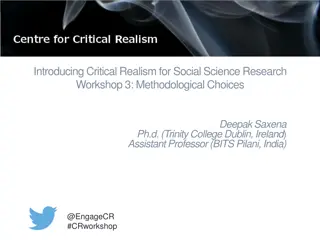Understanding Quantitative Research Design in Social Science
This content covers various aspects of quantitative research design, including descriptive and correlational studies, research design blueprint, robust research design considerations, and different types of research approaches. It emphasizes the characteristics, techniques, and terminologies associated with quantitative research, providing a comprehensive overview for conducting high-quality studies in the field of social science.
Download Presentation

Please find below an Image/Link to download the presentation.
The content on the website is provided AS IS for your information and personal use only. It may not be sold, licensed, or shared on other websites without obtaining consent from the author. Download presentation by click this link. If you encounter any issues during the download, it is possible that the publisher has removed the file from their server.
E N D
Presentation Transcript
Quantitative Descriptive Study Design: Descriptive Correlational Research
By the completion of this presentation, the participant will be able to: Describe three characteristics of a descriptive study Explain two components of a correlational study Discuss the major strengths and weaknesses for one type of descriptive study
Research Design Blueprint Action plan for conducting research study Techniques and procedures Reduces researcher bias Controls for extraneous variables Controls for other sources of variances Produces credible, high quality research findings Clear and detailed: Understand study aim & purpose How research was conducted Evaluate the research process Reproduce research study
Robust Research Design Considers the following: Environment Equivalence Treatment Measurement Extraneous variables Data analysis
Research Design APPROACH TYPES DESIGN QUALITATIVE (discovers) PHENOMENOLOGICAL GROUNDED THEORY ETHNOGRAPHIC HISTORICAL PHILOSOPHICAL QUALITATIVE or QUANTITATIVE (describes) CORRELATIONAL DESCRIPTIVE Non-experimental (Observational) QUANTITATIVE (explains; cause & effect) EXPERIMENTAL QUASIEXPERIMENTAL Experimental
QUANTITATIVE RESEARCH CHARACTERISTICS PHILOSOPHY TECHNIQUES Hard Science New Knowledge Concise and limited focus Tests Theory Reductionistic Explains & Predicts Objective Uses Instruments Logistic and Deductive Reasoning Numbers Statistical Analysis Generalization
TERMINOLOGY RESEARCH APPROACH SOCIAL SCIENCE TERM EXPERIMENTAL MEDICAL RESEARCH TERM Randomized Control Trial; Randomized Clinical Trial (RCT) QUANTITATIVE QUASIEXPERIMENTAL Controlled Trial; Controlled Trial without randomization NONEXPERIMENTAL: DESCRIPTIVE CORRELATIONAL RETROSPECTIVE PROSPECTIVE Observational Studies Case-Series Case-Control Cross-Sectional Cohort Prevalence Incidence
Non-experimental Quantitative Research Descriptive Design Describes phenomena in real life situations that does not manipulate variables Describes, groups, and classifies concepts Generates new knowledge when little or no knowledge is available Examines characteristics of a single sample in order to generalize to a single population Develops models & theories
Descriptive Research Design Case Study In-depth analysis and systematic description of one patient or one group of similar patients No manipulation of variables Common in nursing 40-50 years ago, but are now less frequent Can be used: as evidence to support or invalidate theories to generate new hypotheses for testing to demonstrate effectiveness of Therapeutic techniques
Descriptive Research Design Case Study Case Study: Advantages Wealth of detail Wide variety of information Clues & ideas for further research Understand a topic, concept, issue in general in order to study it in greater detail Case Study: Advantages Hard to control do well and easy to do badly tell if it has been done badly One is often unable to determine if researcher examined the most important topic, clues what was eliminated or not Conclusions only apply the one case Does not create conclusions beyond the one case. Disadvantages explains why case studies are now out of vogue Subjective: Researcher decides What to look for or ignore What to record or not record What is important or not What clues to follow or drop
Descriptive Research Design Case-Series Design Simple descriptive account of interesting characteristics seen in a group of people Short time period Important descriptive role as a precursor to designing other research studies to: Evaluate causes Explanations of observations Acknowledges observed characteristic bias
Descriptive Research Design Cross-Sectional Design Also called Survey, Prevalence, Incidence, Epidemiologic Studies Analyze data collected on a group at one time period Subject and information obtained in a short time frame What is happening Diagnose or stage a disease Usefulness of new or current diagnostic procedures Establishing norms Gain insight into a topic or learn people s perceptions (surveys) Most common research design in nursing
Non-experimental Quantitative Research Descriptive Correlational Design First: Describes variables Second: Examines relationships amongst these variables Does not infer cause-and-effect relationships Facilitates the identification of many interrelationships in a particular situation Situation may have occurred or is currently occurring No attempt to control or manipulate the situation
Non-experimental Quantitative Research Correlational Design Primary purpose is the examination of relationships Examine relationships between 2 or more variables No manipulation of variables Determine if a relationship exists between variables None, weak, moderate, or strong Determine type of relationship between variables Positive relationship or negative relationship
Correlational Research Design Case-Control Design Retrospective in nature Presents phenomenon linked to past phenomenon: What has happened? Looking back in time to detect causes or risk factors for the presence or absence of an outcome Example: Case-Control Studies Cigarette smoking lung cancer People with lung cancer = cases People without lung cancer = controls Differences between groups = smoking
Correlational Research Design One Group Designs: Single Group Descriptive design : no random selection of subjects Convenience or volunteer sample Examine characteristics of a single group Natural setting Measurements made about the group Subjects serve as own control Measure group X1, X2, or more Still one group EXAMPLE: Satisfaction surveys one group over 12 month time period - Use the resulting descriptions to draw conclusions about that groups satisfaction scores
Correlational Research Design One Group Designs: Time Dimension Interrupted Time Series Involves more than one pre and post test measurement Equal number of measurements before and after the intervention The time periods must be constant and equal Longitudinal Time Series Follows one group to examine and measure changes in same subjects over an extended time period
Correlational Research Design One Group Designs: Time Dimension Strengths Weaknesses Allows examination of sequences and patterns of change over both single time period Interrupted time periods Multiple measurements over an extended period Subject drop out Threatens instruments validity & reliability Distorted data Subject keeps a copy of the survey and duplicated responses Hawthorne effect
Correlational Research Design One Group Design: Summary Correlational No random assignment Characteristics of single sample Pre test/post test Time series or multi-variant Longitudinal
Non-experimental Quantitative Research Comparative Descriptive Design Describes variables & examines differences in 2 or more groups Occurs naturally in a setting No manipulation of variables Results obtained from the final analysis are frequently not generalized to a population
Correlational Research Design Multiple Group Designs Group comparative designs Simple 2 group design Post-test design Pre/Post Test Design Time Series Design ADVANTAGES: Comparison of group on dependent variables Examines differences between groups Examines differences within groups Are they coherent groups? Are there true differences between groups? Did change occur re: multiple variables within groups?
Correlational Research Design Multiple Group Designs: Multiple Group Time Series Memory loss in the Elderly: Multiple independent variables Groups: (1) Ginkgo Bilbo (2) Plavix, & (3) No medication (control) Measure via memory test (Pre-test) Low dose & high dose of medications Measure via memory test (Post-test) Repeat Which group demonstrates the best memory scores One dependent variable measured as multiple pre & post tests Constant & equal time periods
Correlational Research Design Multiple Group Designs: Multiple Group Time Series Compare 2 or > groups on natural phenomenon Sometimes called descriptive studies Sometimes called inferential studies Concerns are raised when comparing naturally occurring phenomenon in multiple groups May be better addressed by using quasi-experimental procedures that are inferential, as opposed to correlational procedures
Summary & Conclusions Descriptive Correlational Design Philosophical commonalities Research techniques Lack of variable manipulation & variable control Can result in possible bias see Module 10! Partner with seasoned researchers and statisticians Develop competencies needed to conduct quality research studies Produce credible research findings Impact patient care























